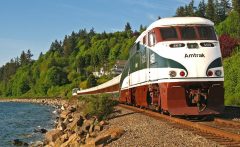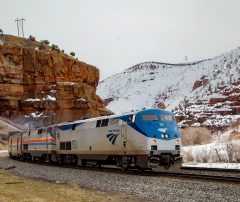In the Cascades train along the Pacific coast – Portland to Seattle

(Cascades train. Photo by Amtrak.)
Amtrak Cascades service between between Portland and Vancouver, BC was fully restored in 2023, after the cuts during the Covid pandemic.
This is an account of my journey on the train between Vancouver and Portland, Oregon, a few years ago.
—-
Shortly after leaving Portland for the mightily beautiful three-hour trip north to Seattle along the Pacific coast, our Amtrak train comes to a gentle stop.
We are briefly marooned on the edge of the broad and far-travelled Columbia River. A view fit for the cover of a travel brochure cover rises up. Nobody complains. There are so many worse places to be stuck on a train.
We enjoy the vista, far up the river into the train’s namesake mountains, the Cascades, part of the chain which runs parallel to the coast from California to British Columbia. This is the most rugged, remote and glaciated stretch, known as the American Alps.
There is silence. Then the conductor comes on the PA to announce brightly: “Folks, they just raised the bridge to let a boat through. So we have stopped. It’s considered bad form to try to cross the river before you put the bridge back down.”
Now that Amtrak’s Cascades Express is spared from a possible rerun of the Tay Bridge disaster, the jovial conductor adds some brief, Oregon Tourist Board-pleasing detail on the river. “1,243 miles long, fourth-largest river in the US. The great explorers Lewis and Clark came this way.”
That is to be a theme of the trip: announcements adding value to the experience. On British trains they only tell us the station, with a nannyish insistence that we don’t leave anything behind, and that we step onto the platform first, before taking any pushchair off. On US trains they prefer to promote their great nation.
No stop was so insubstantial that it doesn’t qualify for a glowing eulogy. “Folks, this is Centralia. Now they sell some mighty fine antiques here.”
I notice the conductor resembles that nice Tom Hanks in Polar Express. But less bossy. And a touch less creative on the ticket punching. He made a good start by suggesting that people sitting near a faulty corridor door might want to move to the next carriage, “because it will get a bit noisy.” He scoops up a piece of litter while telling us this, as if keeping a spotless train was in his job description.
We are riding, and I think the metaphor is appropriate, America’s born-again railroad. The USA and the Iron Way go back a long time. The train helped unite America, sparing pioneers from perilous travel to the west by covered wagon. But the great days of the train ended in the 1950s. Railroad travel was killed by the automobile, the new highways, and the aeroplane.

Are the good time rolling back for Amtrak? Photo – Amtrak
Amtrak, largely owned by the national government, began running trains on a few lines in 1971. The Cascades service started as a single daily round trip between Portland and Seattle in 1993. Now there are four, with two trains a day continuing to Vancouver. Passenger numbers have grown steadily on the West Coast’s bright green lines.
An hour earlier I ewas standing in Portland’s grand and ornate Union Station, waiting for my train and warming my hand on a distinguished cup of railroad coffee — “Coffee Bella Selva, shade-grown, roasted in small batches”.
One of the great ladies of rail was about to arrive. The Empire Builder is a throwback to the railroad’s glory days. It’s the Flying Scotsman, the Golden Arrow and the Blue Train all coupled together, only bigger. The 2,257 miles journey from Chicago had taken nearly 2 days. Amtrak’s advertising slogan, in the land of the occasional hyperbole, is spot on: “The perfect way to experience the rugged splendour of the American West.”
Is the gilded era that train embodied about to return? In November (2023) Amtrak said it had continued its strong growth in 2023 (FY23) as it resumed service on all routes and advanced major infrastructure projects that will support plans to double ridership by 2040. The big growth was fuelled in part by significant growth on the Northeast Corridor (NEC), “where ridership is booming and consistently exceeding pre-pandemic levels since early summer [2023].”
“Customers [are] anxious to travel again and attracted to the many benefits of train travel,” said Amtrak CEO Stephen Gardner. “We’re inspired by the soaring demand for intercity passenger rail and are eager to continue connecting more people and places.”
But that bullish statement was for the future, as I continue my trip north on the Cascades Express. One of the best free shows in the Pacific Northwest is available out of my window. The state of Washington is unwinding at a leisurely pace. Up ahead our engine gives a a demented wail at each level crossing, rolling a continuous carpet of warning over a wide corridor adjoining the line..
The view is deep into the north-west’s sylvan idyll. There are multiple versions of the following: a clearing, with a little farmstead, a pick-up, and some cattle grazing a lush meadow, all set against a backdrop of trees. Further on, denser, wooded slopes clambering up to a noble backdrop of snowcapped peaks. The first one is Mount Hood, one of the reasons Portland is claimed as the beer capital of the USA. Its pure water feeds the city’s breweries.
The peaks grow bigger and meaner. Up ahead is the meanest of all, Mount St Helens. In 1980 the biggest eruption in the US in modern times blew off 400 feet of its top, killing 65. It’s been peaceable lately.
The conductor does a nice line in advance warning. “Folks, in about 10 minutes we arrive at Olympia, state capital.” We learn that the capitol building looks like its namesake in DC. That a VW Beetle would fit sideways into the massive chandelier above the rotunda.
In the buffet car I find the manager telling complete strangers about an entertaining time in his establishment last night. “There were these folks playing Cranium – it’s based on Ludo. Now that’s a great game. By the end we all joined in.” This good nature is infectious, or maybe this is how Amtrak passengers always behave. Two ladies strike up a conversation about knitting. Two more perfect strangers exchange newspapers.
It’s well known that Americans are in thrall to the service ethic, but the example I experienced on my way south from Vancouver a few days earlier, even before we left the station, deserves platinum level recognition.
There was a $6 charge at US immigration. No cards accepted. Immigration didn’t give change or take credit cards. And there was no ATM. The Amtrak man at the gate was determined to help. I had already counted out the right money in coins from past trips I had brought from the UK in a plastic bag. Not bothering to check it, he took my money and went off to find change. He was gone a good three minutes, as the queue built up. He returned with my notes and a “it’s what we do” smile.
On my left the coast has become a series of rocky headlands and quiet bays. Unfamiliar seabirds zing over the placid waters. The port of Tacoma hoves into view, across a big curving bay. “They call it City of Destiny” remarks the conductor. “It has the 500 foot long Bridge of Glass, with three amazing glass installations,”
All the while the biggest surprise of the entire trip is coming ever closer. We round a corner and there, about 50 miles away, is a vision of American grandeur, so epic and unreal I think for a moment it is a reflection from the seat-back TV in the window.
This mountain rightly belongs in the Himalayas. Its top half is swathed in infinite snowfields. Oddly the conductor is too busy preparing us for Seattle to comment on Washington State’s half-size version of Everest. it is only later in the day that I find a postcard in a bookshop and positively identify it as Mount Rainier, 14,410 feet. Excuse my ignorance, geography teachers, but, after all, travel is still meant to be about discovery.
The Cascades Express pulls into Seattle, the end of our trip, for more proof that America has finally stopped beating up its railways.
King Street station looms up against the city’s gleaming high-rise skyline. It is an unexpected memory of Europe. Haven’t I seen that 242 foot tower somewhere? Can it be? Yes it is…an exact replica of Campanile di San Marco in Venice.
In the 60s it was terribly grand and ornate inside. Far too posh for the then declining railroad. So they hit on the smart idea of making it as bland as an airport – although the word they used was “facelift.” Marble walls were overlaid with Formica. Ceilings were dropped to hide elaborate plaster work. A grand staircase was hacked back to half its original size.
In 2005 the city bought the building and began to reverse 30 years of architectural insult. Builders peeled off the dowdy covering and revealed glorious original details fit for a Venetian Doge, while painstakingly replacing the bits that were lost.
They’ve re-laid the hand-cut marble tiles, put back period light fixtures, and replaced a magnificent chandelier. The roof was fitted with new green glazed barrel tiles made by Ludiwici, the same Ohio company which supplied the materials for the original roof in 1906.
I follow this positive proof that the age of “knock ‘em down and build something new” may finally be over in the US, for a small but pleasant surprise to end my trip. After fumbling around for change for the bus trip to my hotel, I find – and I bet the taxi drivers grumble – that all the buses and trolleys in downtown Seattle are free.
The writer travelled as a guest of Amtrak. www.amtrak.com
My article on a train ride on the Heart of Wales line.